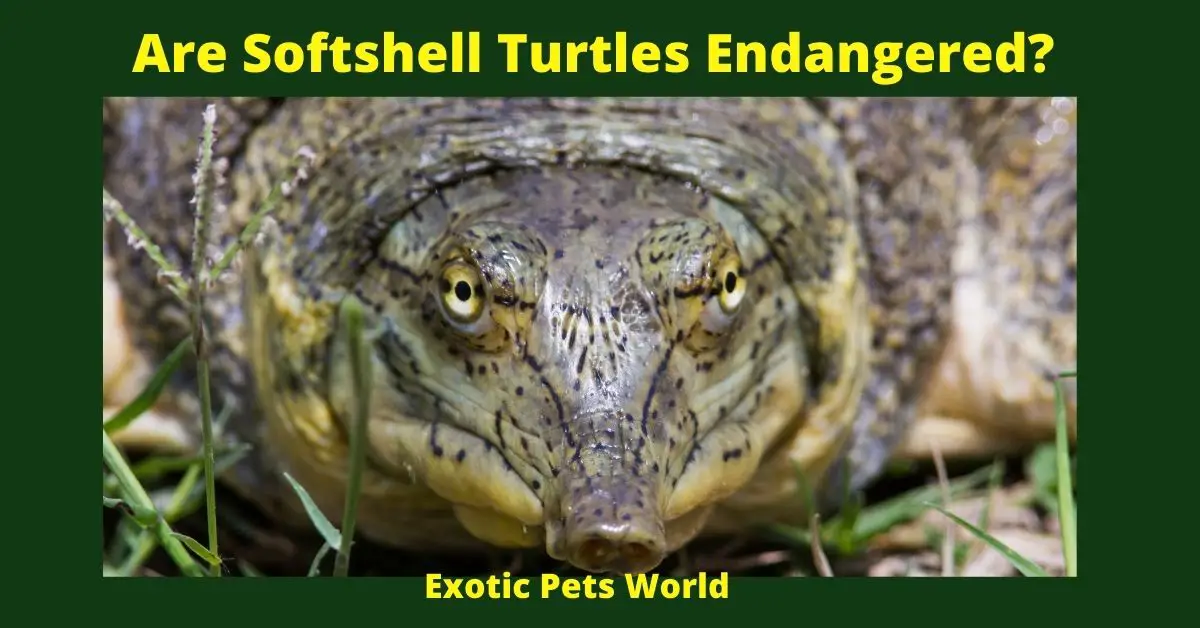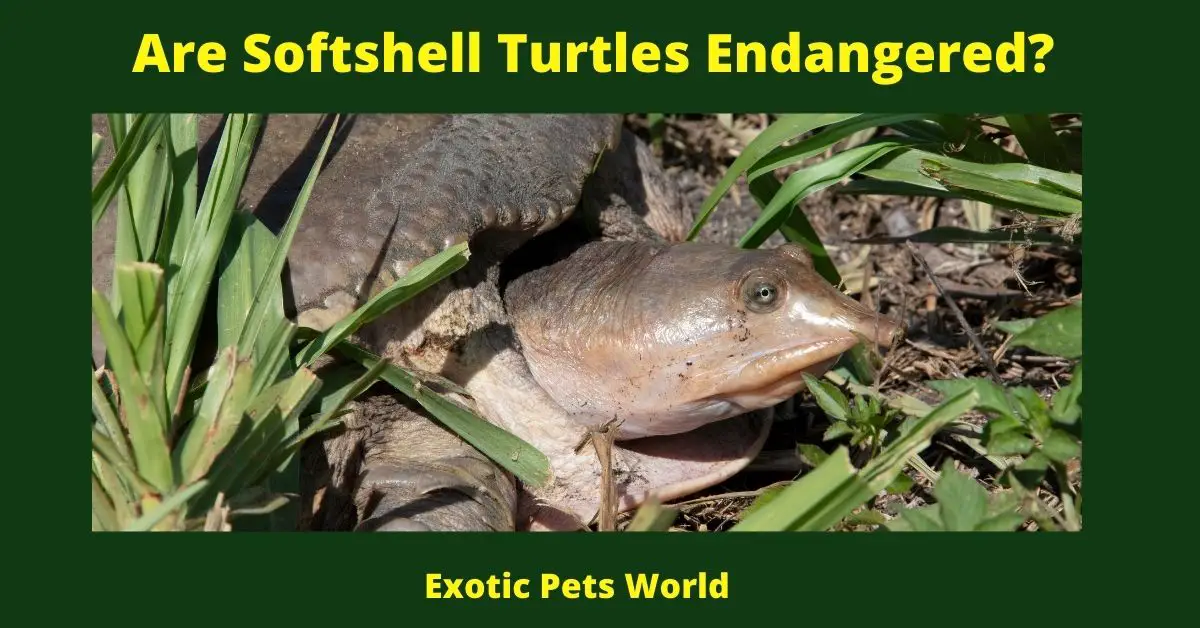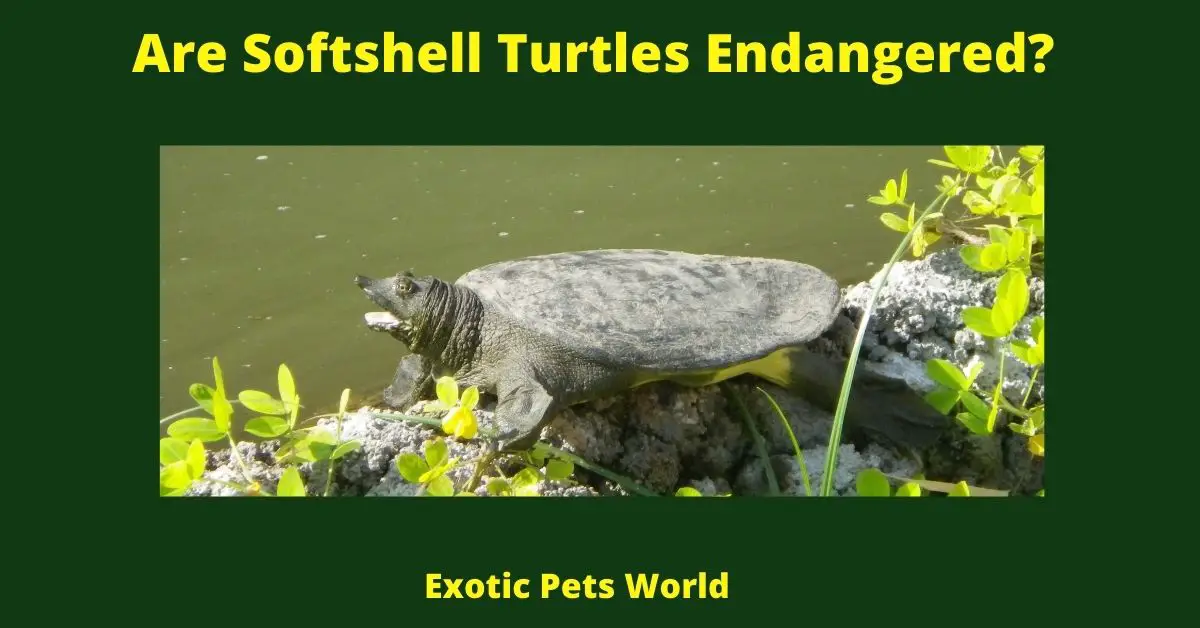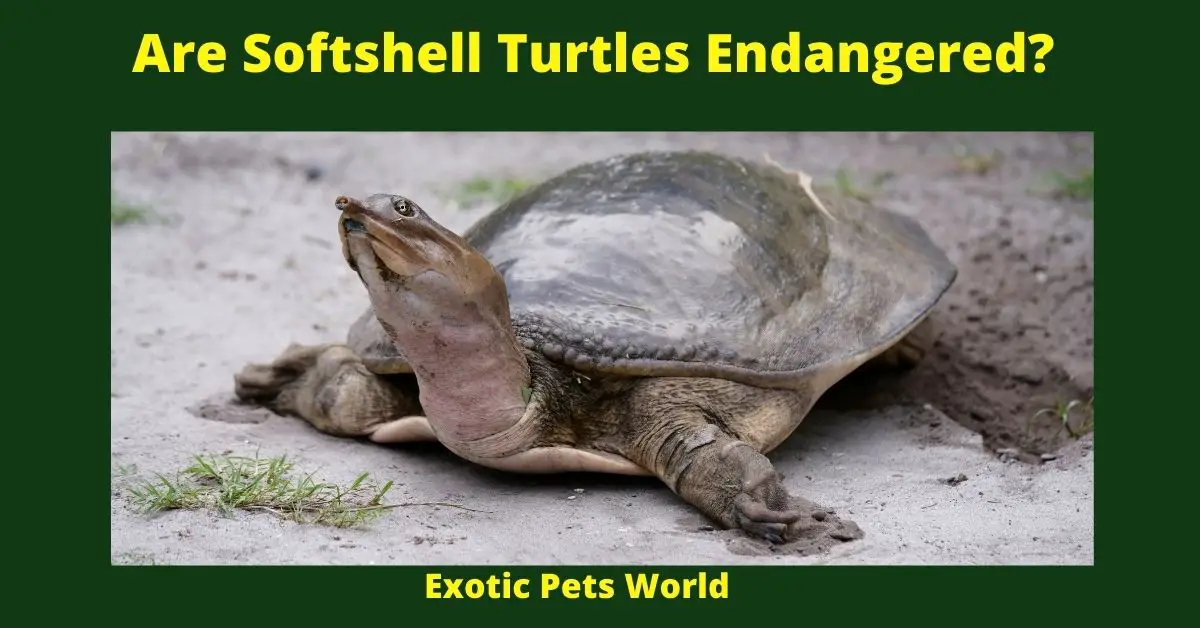Are Softshell Turtles Endangered?
The softshell turtle is a species of aquatic reptile that is found in many parts of the world. These turtles are considered to be endangered in some areas, and it is important to learn more about them so that we can protect them. In this article, we will discuss the softshell turtle’s anatomy, habitat, and why they are endangered. We will also provide tips on how you can help protect these amazing creatures!
History of Softshell Turtles
The History of the Softshell turtle species starts in the Cretaceous period, approximately 150 million years ago. They were one of the largest freshwater turtles in the world and could weigh up to 200 pounds! Softshell turtles have changed very little over the last few hundred thousand years and their population was estimated at around 20 million individuals. Are Softshell Turtles Endangered?
Today, however, softshell turtle populations are in decline due to a variety of factors including habitat loss, pollution, hunting, and egg harvesting. In some parts of the world, they are considered endangered, such as in China where they are listed as “vulnerable.”
Anatomy of a Softshell Turtle
Softshell turtles get their name from their unique shell which is made up of leathery skin instead of hard scales. This makes them much more flexible than other turtles, which is an advantage when they are swimming in fast-moving water.
Their shells also have a darker coloration that helps them to blend in with their surroundings. This is helpful because it makes it more difficult for predators to spot them. Softshell turtles can grow to be quite large, with some individuals reaching lengths of up to four feet!

Habitat of the Softshell Turtle
Softshell turtles live in a variety of habitats including ponds, lakes, rivers, and even swamps. They prefer areas where there is soft mud so that they can bury themselves and stay hidden from predators. These turtles are excellent swimmers and often travel long distances between different bodies of water.
Why are Softshell Turtles Endangered?
There are many reasons why softshell turtles are endangered. One of the biggest threats to these turtles is habitat loss. As humans continue to develop land for housing and other purposes, natural habitats are being destroyed. This leaves less space for softshell turtles to live and breed.
Another threat to these turtles is pollution. When water is polluted with chemicals, it can be harmful to softshell turtles. They may ingest toxic substances or absorb them through their skin, which can make them sick or even kill them.
Hunting and egg harvesting are also contributing to the decline of softshell turtle populations. In some parts of the world, these turtles are considered a delicacy, and their meat is sold in markets. Their eggs are also often collected from nests and sold as a food items.
How You Can Help Protect Softshell Turtles
There are many ways that you can help protect softshell turtles. One of the most important things you can do is to support organizations that work to conserves these creatures. You can also volunteer your time or donate money to help fund their conservation efforts.
You can also help by spreading awareness about the plight of softshell turtles and educating others about why they need protection. When people understand the importance of these animals, they may be more likely to take steps to help conserve them.
- Largest freshwater turtles – There are a variety of freshwater turtles in the world, but none as large as the softshell turtle.
- World population – The global population of softshell turtles is estimated at around 20 million individuals.
- Outlook for future generations – While there are many threats to softshell turtle populations, with continued conservation efforts they may be able to rebound. There is hope for the future of these amazing creatures!
Are These Endangered Turtle Species Endangered?
- Yangtze giant Turtle – The Yangtze giant turtle is one of the most critically endangered turtles in the world. There are only a few hundred left in the wild.
- Smooth softshell turtles – The smooth softshell turtle is also critically endangered with a population size of less than 1000 individuals.
- Wild Turtles – Wild turtles are not considered to be an endangered species, but many populations are declining due to habitat loss and poaching.
- Hoan Kiem turtle – The Hoan Kiem turtle is also known as the “sacred” or “Emperor” turtle and is listed as vulnerable by IUCN. It is estimated that there are only around 150-200 adults remaining in the wild.
- Spiny Softshell Turtle (Apalone spinifera) – The spiny softshell turtle is listed as endangered by IUCN with a population size of less than 1000 individuals.
- Giant soft-shell turtle – The giant soft-shell turtle is the largest freshwater turtles in the world and is also listed as endangered by IUCN. It is estimated that there are only around 250-300 adults remaining in the wild.
- Female spiny softshell turtles – Female spiny softshell turtles are critically endangered with a population size of less than 1000 individuals.
- Marine turtle species – Marine turtles are considered to be one of the most threatened groups of animals on the planet. Of the seven marine turtle species, four are listed as vulnerable, two are listed as endangered, and one is critically endangered.
- Midland smooth softshell – The midland smooth softshell turtle is listed as endangered by IUCN with a population size of less than 1000 individuals.
- Eastern spiny softshell – The eastern spiny softshell turtle is listed as endangered by IUCN with a population size of less than 1000 individuals.
- Male smooth softshell – Male smooth softshell turtles are critically endangered with a population size of less than 1000 individuals.
Habitat of the Endangered Spiny Softshell Turtle
The natural habitat of the spiny softshell turtle is freshwater, either a river or stream. They are found on the bottom or basking on logs near the shoreline. The female turtles will travel up to three miles from their nesting site to find a suitable location to lay their eggs.
The baby turtles hatch two months later and immediately head for the water. It can take up to ten years for a spiny softshell turtle to reach adulthood.
The spiny softshell turtle is an endangered species due to loss of habitat, being hunted for food, and being caught in fishing nets. You can help by not buying products made from their shells, and by supporting organizations that are working to protect their habitat.

Places that Softshell Turtles are Endangered?
Softshell Turtles are endangered in the world in the following locations:
North America
- The pike river in the United States is a place where softshell turtles are endangered.
Asia
- The Red River in Asia
- Xuan Khanh lake
- Hoan Kiem Lake
- Enormous Yangtze – Yangtze river
- The waters of the Yunnan province of china are also a place where they are critically endangered.
- Dong Mo Lake is also a place where they are endangered.
Characteristics of Softshell Turtles
- Long necks – Softshell turtles have long necks which help them to reach food and breathe underwater.
- Deepwater – They are also able to live in deep water as well.
- Small spines – On their backs they have small spines that protect them from predators.
- Long snout – Their long snout helps them to find food in the murky water.
- Underwater Breathing – They are able to breathe under water due to their specially adapted lungs.
- Sandy areas – They prefer sandy areas where they can bury themselves when necessary.
- Large rivers – They are mainly found in large rivers where there is plenty of food and shelter.
- Upper shell– The upper shell, or carapace, is leathery and does not have any spines.
- Spiny projections – On the lower shell, or plastron, they have small spines that help them to move around on land.
- Leathery carapace– The carapace is leathery instead of hard like most turtles.
- Female’s head – The female’s head is smaller and more rounded than the male’s head.
Key Takeaways:
- There are only around 150-200 adults remaining in the wild of the endangered Spiny Softshell Turtle.
- They live mainly in large rivers where there is plenty of food and shelter.
- Their upper shell, or carapace, is leathery and does not have any spines
Lifecycle of Softshell Turtles
- Sex of the animals – Male and female softshell turtles can be distinguished by the size and shape of their heads. The female’s head is smaller and more rounded than the male’s head.
- Artificial insemination – Artificial insemination is occasionally used to help preserve the species.
- Female turtle – After a mating ritual, the female will lay her eggs in a nest that she has dug in the sand. She will then cover the eggs with sand and return to the water.
- Eggs – The eggs hatch two months later and immediately head for water.
- Hatchlings – It can take up to ten years for a spiny softshell turtle to reach adulthood.
- Youth – Young softshell turtles spend most of their time in water, but will leave the water to sun themselves on logs or shores.
- Sexual maturity – It is not known when softshell turtles reach sexual maturity, but it is thought to be around 12-15 years old.
- Lifespan – The lifespan of a softshell turtle is around 50 years in the wild, and up to 60 years in captivity.
- Late spring – Mating season for softshell turtles usually occurs in late spring.
Key Takeaways:
- The female spiny softshell turtle will lay her eggs in a nest that she has dug in the sand. She will then cover the eggs with sand and return to the water.
- It can take up to ten years for a spiny softshell
What is the Diet of Softshell Turtles Consist of?
The Diet of Softshell Turtles consist of:
- Aquatic insects – such as dragonflies, mayflies, and water bugs
- Mollusks – such as snails and clams
- Frogs – such as green tree frogs and bullfrogs
- Fish – such as bass, catfish, sunfish, and carp
- Insects – Softshell turtles are carnivores and their diet consists mainly of aquatic insects.
- Mollusks – Some softshell turtles will also eat mollusks, which are a type of shellfish.
Why are Softshell turtles becoming Endangered?
- Habitat destruction – One of the primary reasons why softshell turtles are becoming endangered is due to habitat destruction. This can come in many forms, such as deforestation, urbanization, and water pollution.
- Brink of extinction – Softshell turtles are also becoming endangered because they’re on the brink of extinction. There are only a few hundred left in the wild, and their numbers are rapidly declining.
- Water levels – Another reason for their decline is that water levels in their habitats are dropping. This is due to climate change and human activity, such as damming and irrigation.
- Habitat loss – As water levels drop, so does the amount of suitable habitat for softshell turtles. This loss of habitat is one of the main drivers of their decline.
- Climate Change – Climate change is also a major factor in the decline of softshell turtles. As temperatures rise and habitats change, it becomes more difficult for these turtles to find food and shelter.
- Conservation of nature – The conservation of nature is important for the preservation of all species, including softshell turtles. There are many ways to conserve nature, such as creating protected areas, managing human activity, and restoring habitat.
- Habitat degradation – Another reason why softshell turtles are becoming endangered is habitat degradation. This can occur due to pollution, invasive species, and other human activities.
- Human disturbance – One of the biggest threats to softshell turtles is human disturbance. This includes things like boat traffic, fishing, and swimming their habitats.
- Rural development – Another threat to softshell turtles is rural development. This includes things like road construction, housing developments, and agriculture.
- No legal protection – One of the biggest problems facing softshell turtles is that they have no legal protection. This means that their habitats can be destroyed without any consequences.
- Edge of extinction – The edge of extinction is a very real danger for softshell turtles. If we don’t take steps to protect them now, they could soon disappear from the planet altogether.
- Destruction of its habitat – The destruction of a species’ habitat is one of the main reasons why they become endangered. If we don’t take steps to protect their habitats, then we’ll lose these animals forever.
- Loss natural environments – As we lose natural environments, we lose the species that live in them. This is why it’s so important to protect our ecosystems and all the animals that call them home.

Places To Find More Information on Endangered Turtles
Some places you can look for more information on Endangered Turtles
- Teams of conservationists – Wildlife conservation society, Suzhou zoo, Turtle survival alliance, Nature Conservancy of Canada, Quebec government , Asian turtle program , Assam Forest department
- Factual websites – IUCN red list, chelonian research institute, ARKive
- There are many ways you can help endangered turtles – donating to or volunteering for organizations working to help them, reducing your consumption of plastic and other polluting materials (which often end up in the ocean and can be mistaken for food by turtles), supporting businesses that sustainable practices. You can also support zoos and aquariums that have turtle exhibits and participate in their educational programming to learn more about these amazing creatures and how to help protect.
- The Wildlife Conservation Society (WCS) has been working to conserve turtles for over two decades all around the world. WCS’s global turtle program works on research, field conservation, and education projects in more than 20 countries. You can learn about their work on their website and also sign up to be a “Turtle Defender” to take action to help turtles.
- The Suzhou Zoo in China has created a special breeding program for endangered turtles. The zoo is home to over 200 species of reptiles, including many endangered turtles. You can learn more about the Suzhou Zoo and their efforts to protect turtles on their website.
- The Turtle Survival Alliance (TSA) is a global network of zoos, aquariums, conservation organizations, and individuals committed to saving turtles from extinction. TSA works on research, captive breeding, field conservation, and education projects all over the world. You can learn more about their work on their website and also sign up to be a “Turtle Protector” to take action to help turtles.
- The Nature Conservancy of Canada (NCC) is Canada’s leading land conservation organization. NCC works to protect important natural areas and the species that depend on them. They have many turtle conservation projects across Canada. You can learn more about their work on their website and also sign up for their e-newsletter to stay up-to-date on their latest news.
- The Quebec government has created the “Plan québécois de la tortue terrestre” (PQTT) to help protect turtles in Quebec. The PQTT is a plan for research, conservation, and education about turtles in Quebec. You can learn more about the PQTT on their website.
- The Asian Turtle Program (ATP) is a partnership of governments, zoos, NGOs, and universities working to save endangered turtles in Southeast Asia. ATP works on research, captive breeding, field conservation, and education projects all over Asia. You can learn more about their work on their website.
- The Assam Forest Department in India has created the “Turtle Conservation Project” to help protect turtles in Assam. The project is working on research, conservation, and education about turtles in Assam. You can learn more about the project on their website.
- The Canadian government has created the “Sustainable Aquaculture Stewardship Program” (SASP) to help promote sustainable aquaculture practices. One of SASP’s goals is to reduce the impact of aquaculture on aquatic species, including turtles. You can learn more about SASP on their website.
- Environmental DNA (eDNA) is a new technology that can be used to study the distribution and populations of endangered species. eDNA can be collected from water, soil, or other environmental samples. It can be used to detect the presence of a species even if it is not visible. You can learn more about eDNA on their website.
Final Thoughts – Are Softshell Turtles Endangered?
There are many things you can do to help protect turtles from becoming endangered. You can consume less plastic and other polluting materials, support businesses that sustainable practices, learn about turtle conservation projects, and take action to help protect turtles.
There are also many ways you can learn more about these amazing creatures including visiting zoos and aquariums with turtle exhibits, reading articles and blog posts about turtles, and watching documentaries about them. So please, do your part to help these amazing creatures and learn more about them!

It’s amazing designed for me to have a web site,
which is valuable for my know-how. thanks admin
Hi i am kavin, iits my fiirst time to commenting
anywhere, when i read this post i thought i could also make comment due to his good piece of writing.